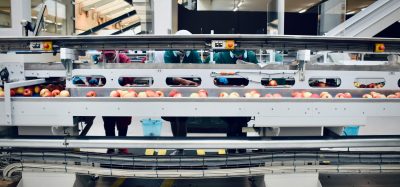Conveying the truth
- Like
- Digg
- Del
- Tumblr
- VKontakte
- Buffer
- Love This
- Odnoklassniki
- Meneame
- Blogger
- Amazon
- Yahoo Mail
- Gmail
- AOL
- Newsvine
- HackerNews
- Evernote
- MySpace
- Mail.ru
- Viadeo
- Line
- Comments
- Yummly
- SMS
- Viber
- Telegram
- Subscribe
- Skype
- Facebook Messenger
- Kakao
- LiveJournal
- Yammer
- Edgar
- Fintel
- Mix
- Instapaper
- Copy Link
Posted: 31 January 2005 | Tim Lloyd, New Food | No comments yet
Conveyor belts are the arteries of all food processing sites. They support products from a raw material stage to final packaging and endure all the processes in between. They must be able to work safely and effectively with all manner of different product characteristics, from viscous ingredients to raw meats. But how do conveyor belt manufacturers match the fast-paced development of food products, with belts that are up to the task? And what changes do they foresee for tomorrow’s manufacturing environment? New Food met with six leading conveyor belt manufacturers to find out.
Conveyor belts are the arteries of all food processing sites. They support products from a raw material stage to final packaging and endure all the processes in between. They must be able to work safely and effectively with all manner of different product characteristics, from viscous ingredients to raw meats. But how do conveyor belt manufacturers match the fast-paced development of food products, with belts that are up to the task? And what changes do they foresee for tomorrow’s manufacturing environment? New Food met with six leading conveyor belt manufacturers to find out.
Conveyor belts are the arteries of all food processing sites. They support products from a raw material stage to final packaging and endure all the processes in between. They must be able to work safely and effectively with all manner of different product characteristics, from viscous ingredients to raw meats. But how do conveyor belt manufacturers match the fast-paced development of food products, with belts that are up to the task? And what changes do they foresee for tomorrow’s manufacturing environment? New Food met with six leading conveyor belt manufacturers to find out.
Safety fast
Food manufacturing has witnessed many changes and developments in the past ten years. We asked our panel how the application of conveyor belting has progressed in that time.
As plants and production lines have continued to grow, conveyor belts have become an increasingly important part of the process, according to Olaf Heide, Habasit. “High speed production lines, more demanding applications and extended production cycles – three shifts, sometimes seven days a week” are all typical examples of how conveyor belting has become more important than ever, says Olaf.
One notable improvement highlighted by Belt Technologies is that of belt flatness. “Technical advances in materials in the last ten years has meant that the cooking surface will remain flat up to approximately 400ºF,” according to Al Wosky, Operations Manager at Belt Technologies.
All members of our panel agree that hygiene is a primary driver for development and, as Anke Grau of Siegling points out, “the sensitivity of food producers [to hygiene issues] has increased because of new directives and legal changes.” Hygiene is a key factor in Berndorf Band’s marketing of key belts. “Detergents and sanitisers have become more aggressive and the quantity used has also increased, leading to a need for more resistant belt materials”, says Heinrich Garherr, Berndorf Band’s Business Development Manager. They also cite an evolution in processing machinery, which now means that belts must be wider than before.
Han van Gortel of Intralox believes that conveyor belting has actually played a significant role in allowing production facilities to become more automated: “many conveying systems have been installed to connect the different steps and applications in the manufacturing process. One can estimate that the level of automated conveyance in food manufacturing has more than doubled in the last ten years.”
Besides conveyor belting serving as a tool in the automation process, increased demands from automation have helped to revolutionise the development of the belts themselves. “Trends towards improving product safety, hygiene and purity has led to new materials, new designs and new government regulation”, says Kay Baerenfaneger, Ammeraal Beltech.
Rising to the challenge
Installing a new conveyor system in a factory is no mean feat, but what are the biggest challenges facing the supplier? Our expert panel agree that a thorough understanding of the immediate production environment is essential. “Understanding the food processing requirements is important,” says Mr Heide, “and a need for skilled personnel.” Heinrich Garherr points out that a “quick and easy installation, using as few personnel as possible, keeps production losses and costs low.” This, in turn, has increased pressure for the development of smart tools and installation devices.
It is only when the installation process is broken down into stages that one realises the work involved. “The mechanical condition of the conveyor has to be square and true,” says Kay Baerenfaenger, “free from obstructions, debris and sharp edges. The belt must be properly sized, tensioned and tracked. Following installation, training consultations with production, maintenance and sanitation staff is useful in avoiding unnecessary abuse and prolonging belt life in the application.”
Intralox believe that one of the greatest risks when installing conveyors is that customers try to standardise on certain belts: “this is not always possible,” says Han van Gortel, “different properties are required throughout the manufacturing process. Sometimes these processes require new belt properties, so new types of belt or materials must be developed to satisfy the customer’s requirements.”
Al Wosky believes retro-fitting endless belts to an existing production line is the biggest headache: “Typically, food conveyor lines are long, with numerous support equipment built in: this is difficult, if not impossible, to remove, in order to install an endless belt.”
Meeting all the criteria
The range of conveyors on offer to food processors is vast. We asked our panel what factors they felt influenced purchaser’s decisions when a new conveyor has to be sourced.
It appears there are two broad criteria: processors need a product that meets their production needs, but a product that is also presented as part of an attractive overall package. Olaf Heide believes that customers are looking for “relevant experience and references, service availability, quality materials, durability and a competitive price.” These all appear quite obvious, but may often be overlooked. Anke Grau is quick to point out that the mechanical design of the installation may also influence the selection of a conveyor. “Mechanical considerations include pulley sizes and belt path, tensioning availability, angle of inclination and the anticipated conveyor loading,” says Kay Baerenfaenger.
According to Heinrich Garherr, thermal processes require careful consideration too: “these basically require high heat conductivity and low thermal expansion.”
Han van Gortel adds that, on the product front, considerations must include contact approval of the belt material, non-stick effects, product transfer requirements and cleanability.
Moving to the future
Surely a conveyor is a conveyor? Not so according to the experts. Although the concept and design may remain fundamentally unchanged, our panel is agreed that the next big developments will make conveyors even more hygienic. “A major development may be belt surfaces and materials that prevent further growth of bacteria colonies,” says Han van Gortel. Gortel anticipates that more food manufacturing plants will install clean-in-place (CIP) systems, allowing factories to constantly clean belting systems during production, or improve cleaning sessions after production.
Kay Baerenfaenger goes one step further: “Perhaps the next innovation is the ‘Smart Belt’ – one that is able to detect the presence of unsafe levels of contamination on the surface of the belt itself.” Al Wosky concurs: “With continued advances in coating technology, the cleaning process should become easier as the durability and release characteristics improve.” Olaf Heide highlights the importance of introducing new cleaning procedures, “avoiding, or at least limiting, the use of water, thus helping to avoid cross contamination and build-up of bacteria.”
In addition to hygiene improvements, Anke Grau anticipates more development requests resulting from increasingly stringent national and international regulations such as ATEX.









